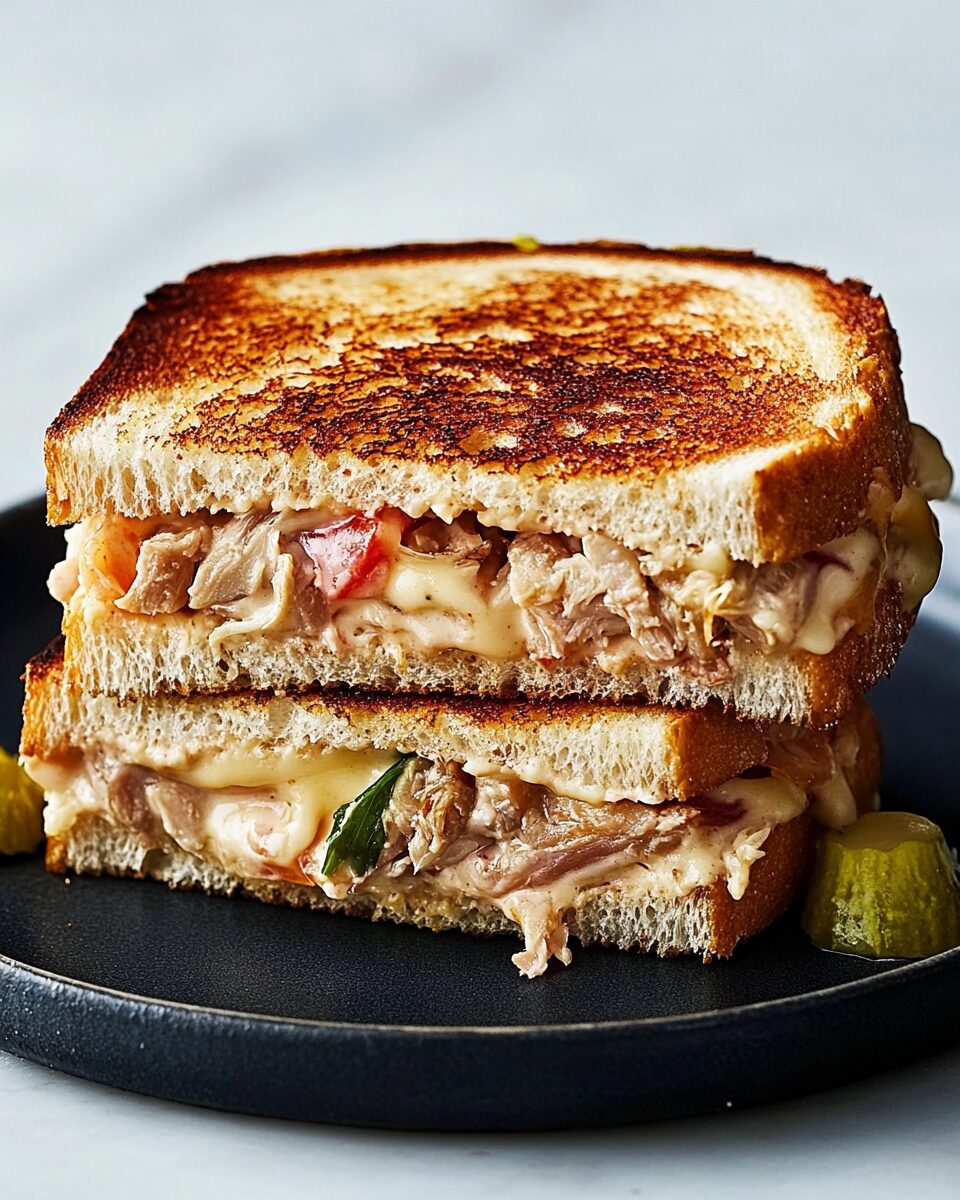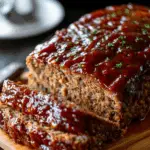The combination of tangy tuna salad, creamy mayonnaise, and sharp cheddar cheese creates a satisfying and flavorful filling for crispy sourdough bread.
This recipe is easy to customize to your taste and dietary preferences. You can use any type of bread you like, or add extra ingredients such as pickles or olives to the tuna salad. This dish is perfect for a cozy dinner at home, a picnic, or any occasion where you want to enjoy a comforting and delicious meal.
Full Recipe
Ingredients:
-
3 (6-ounce) cans water-packed tuna, drained
-
½ cup + 2 tablespoons mayonnaise
-
¼ cup capers, drained
-
2 tablespoons finely chopped red onion
-
1 tablespoon lemon zest
-
3 tablespoons lemon juice (from 1 lemon)
-
1 tablespoon chopped fresh dill
-
2 teaspoons Dijon mustard
-
½ teaspoon kosher salt
-
½ teaspoon freshly cracked black pepper
-
2 tablespoons salted butter, softened
-
8 slices crusty sourdough bread (about ½ inch thick)
-
8 slices extra-sharp white cheddar
Directions:
-
In a medium bowl, combine the tuna, ½ cup of the mayonnaise, capers, onions, lemon zest, lemon juice, dill, mustard, salt, and pepper. Stir, breaking up the tuna with a fork.
-
In a small bowl, combine the remaining 2 tablespoons mayonnaise and butter. Spread one side of each slice of bread with the mayonnaise mixture. Spread ½ cup of the tuna mixture onto the opposite side of the bread slice. Top the tuna with two slices of cheddar and another bread slice, spread-sides up. Repeat with remaining ingredients to make 4 sandwiches total.
-
Heat a large skillet until hot over medium-low heat. Add 2 of the sandwiches to the skillet, before turning the heat down to low. Cook, undisturbed until golden brown, and the cheese is melted, 5-6 minutes per side. Transfer to a plate and repeat with the remaining sandwiches.
-
Cut the sandwiches in half and serve immediately.
Prep Time: 10 minutes
Cooking Time: 15 minutes
Total Time: 25 minutes
Kcal: 743 kcal
Servings: 4 servings
The Irresistible Allure of the Classic Tuna Melt
Few comfort foods hit the nostalgic sweet spot quite like the tuna melt. With its perfectly grilled, golden-brown bread, creamy, zesty tuna salad, and gooey layer of melted cheddar cheese, this sandwich bridges the gap between a hearty lunch and a soul-satisfying dinner. It’s an enduring diner staple that transcends trends, loved by generations for its humble ingredients and indulgent flavor. The classic tuna melt is one of those recipes that seems simple at first glance but offers a complexity of flavor and texture that keeps you coming back for more.
This article dives into the culinary charm of the tuna melt—its history, versatility, cultural relevance, nutrition, tips for the perfect preparation, and why it remains a beloved fixture in kitchens and cafes alike.
A Brief History of the Tuna Melt
The tuna melt’s origins are rooted in American diner culture, with records tracing it back to the mid-20th century. It was likely born out of culinary improvisation—someone placing a scoop of tuna salad on toast, topping it with cheese, and tossing it under a broiler. Over time, the combination was refined, finding its way onto diner menus across the U.S. and becoming synonymous with homestyle meals and cozy lunches.
Tuna salad itself dates back to the early 1900s, when canned tuna became widely available and affordable. Combining it with mayonnaise, pickles, celery, and other pantry staples became a common way to make it stretch into a full meal. The innovation of adding cheese and grilling the sandwich brought a new dimension to this otherwise cold dish.
What Makes the Tuna Melt Special?
Unlike cold sandwiches or traditional grilled cheese, the tuna melt fuses both ideas. You get the richness of melted cheese, the freshness and tang of a well-seasoned tuna salad, and the satisfying crunch of toasted bread. Each element plays its part:
-
Tuna offers protein and a mild seafood flavor that pairs well with many seasonings.
-
Mayonnaise adds creaminess and moisture.
-
Lemon juice and zest bring brightness.
-
Capers and mustard cut through the richness with briny sharpness.
-
Sharp cheddar provides a bold cheesy kick.
-
Sourdough or artisan bread adds texture and a slight tang that complements the filling.
These combined flavors result in a deeply satisfying eating experience, where each bite balances creamy, crispy, salty, and tangy components.
Variations and Adaptability
One of the reasons the tuna melt has endured for so long is its adaptability. While the basic version includes tuna salad, cheddar, and bread, the possibilities for customization are nearly endless. You can:
-
Swap in different cheeses like Swiss, provolone, gouda, or pepper jack for a spicier kick.
-
Use whole grain, rye, multigrain, or even gluten-free bread.
-
Add sliced tomatoes, pickles, or avocado for extra texture and flavor.
-
Replace mayonnaise with Greek yogurt or mashed avocado for a lighter twist.
-
Spice up the tuna salad with hot sauce, jalapeños, or red pepper flakes.
-
Use canned salmon or chicken instead of tuna for a different protein base.
This adaptability means the tuna melt can fit a wide range of dietary needs, from low-carb to pescatarian to high-protein, depending on how it’s prepared.
Cultural Impact and Popularity
The tuna melt has remained a classic through decades of changing food trends. Whether you’re enjoying one at a local diner, making a quick version at home, or seeing it featured on food shows, the tuna melt continues to maintain its cultural relevance. It’s comfort food at its finest—reliable, familiar, and endlessly customizable.
During the 2020 lockdowns, recipes like the tuna melt surged in popularity as people returned to home cooking and nostalgic foods. Searches for comfort dishes spiked, and the tuna melt reappeared as a viral favorite on food blogs, social media platforms, and YouTube cooking channels.
Its continued presence on restaurant menus, especially in American-style cafes and diners, proves it’s not going anywhere anytime soon.
Nutritional Overview
While not a “light” food by traditional standards, the tuna melt can be a nutrient-rich meal depending on how it’s made. Tuna is an excellent source of lean protein, omega-3 fatty acids, and essential vitamins like B12 and D. When combined with whole grain bread and fresh herbs, it can be a balanced and wholesome dish.
For those watching their fat intake, using low-fat cheese, light mayo, or non-dairy alternatives can make the tuna melt healthier without sacrificing flavor. The addition of fresh vegetables like tomatoes, spinach, or arugula also boosts its nutritional value.
Tips for the Perfect Tuna Melt
To make a truly exceptional tuna melt, a few key tips can take your sandwich from basic to gourmet:
-
Use high-quality tuna: Opt for solid white albacore in water for the cleanest flavor and best texture.
-
Balance moisture: Too much mayo or lemon juice can make the sandwich soggy. Aim for a creamy but not wet filling.
-
Grill low and slow: Cooking on medium-low heat ensures that the bread toasts evenly while giving the cheese enough time to melt without burning the outside.
-
Butter both sides: A mix of butter and mayonnaise on the bread results in a beautifully golden crust with rich flavor.
-
Don’t skimp on the cheese: Sharp cheddar offers the best contrast to the mellow tuna. Two slices per sandwich usually work best for the ideal melt factor.
Serving Suggestions
The tuna melt is a complete meal on its own, but pairing it with a few simple sides can elevate it into something even more satisfying. Consider serving it with:
-
A crisp green salad with vinaigrette
-
Classic kettle chips or sweet potato fries
-
A cup of tomato soup for a nostalgic diner experience
-
Pickles or coleslaw for a crunchy contrast
For beverages, iced tea, a light lager, or sparkling water with lemon complements the richness of the melt beautifully.
Why Everyone Should Master This Recipe
Whether you’re a beginner cook or an experienced foodie, the tuna melt should be in your kitchen repertoire. It comes together in under 30 minutes, uses pantry staples, and never fails to impress. It’s a great way to introduce kids to new flavors, and also makes an excellent work-from-home lunch or casual dinner.
Moreover, it teaches valuable cooking techniques—like balancing textures, seasoning a filling, and achieving a perfect golden crust—that translate into many other dishes.
Conclusion
The tuna melt is more than just a sandwich—it’s a culinary icon that embodies everything we love about comfort food: it’s warm, familiar, easy to make, and infinitely customizable. From its humble beginnings in American diners to its current status as a nostalgic classic reimagined in home kitchens, the tuna melt proves that great food doesn’t need to be complicated.
With just a few ingredients and a hot skillet, you can create a meal that satisfies both your hunger and your soul. Whether you’re revisiting a childhood favorite or discovering it for the first time, the tuna melt is a dish that always delivers.
If you haven’t made one in a while—or ever—there’s no better time than now to fire up the stove and toast your way to cheesy, tuna-filled bliss.






